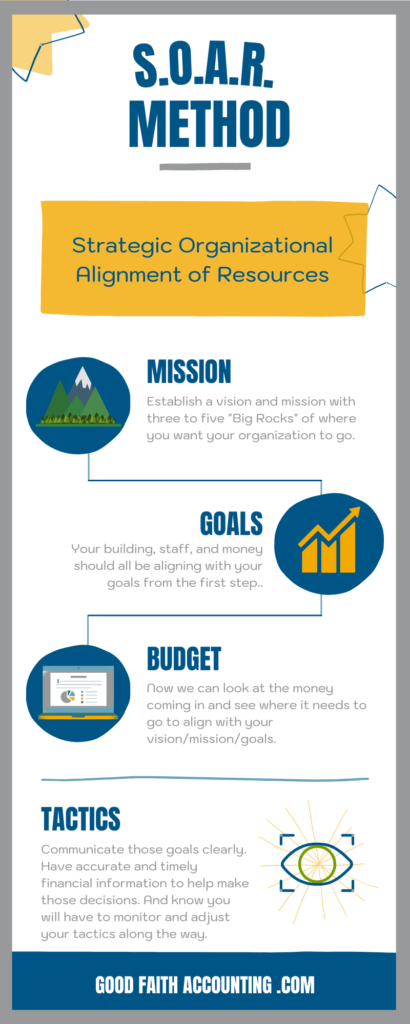February 18, 2022
Purpose Driven Budget – SOAR
In our first post in this series we discussed the different types of budgets, and went through all the acronyms but one: SOAR. Today, the wait is over! We will go into detail on the SOAR Budgeting Method.
To recap, our team came up with several different types of budgets; from no budget at all, to duplicating previous years, to taking a cursory look at the money that was spent and making slight adjustments. While the last one isn’t all bad, we know there is room for better.
You Might Also Like: The SOAR Budget Podcast
Some highlights from the podcast episode include:
- There are a few different styles of budgets: Hope and a Prayer Budget, Unrealistic Budget, and No Margin.
- Another hot tip is to make sure you are working with accurate reports and data.
- Make sure to keep teaching and preaching about stewardship to your constituents.
- Lastly, find out how much safety/strategic reserves your organization should have. (Spoiler: scroll to the end for this info. We couldn’t help but include it here.)
The SOAR Budget Method
Now back to the post at hand.

With the Strategic Organizational Alignment of Resources (aka the S.O.A.R.) method, the goal is to align our resources with what God has given us.
Top Four To-do’s:
- Establish Vision/Mission – That will give us our blueprint for the future. Then we can come up with three to five “Big Rocks” of where you want the organization to go.
- Create Annual Goals & Objectives – These will provide the necessary keys to effective resource allocation (resources are defined as: buildings, staff, volunteers, and oh, money). “What we focus on is what we become.” – Frederick Lenz
- Formulate the Budget – With these prior steps in place, we are then ready to tackle the financial end of the budget process. See what money is coming in and how it can support your Big Rocks.
- Develop Tactics & Communication – These goals will give us the people and communication planning necessary to become more effective. Don’t forget to monitor and adjust as you go.

Is the SOAR Budgeting Method Better Than the Rest?
First, let’s take a look at the disadvantages of this method. This model takes more time than any other model. It forces people to examine their respective goals and budgets and can damage egos in the process. Second, SOARing takes training and trial and error, which most folks don’t appreciate. It requires a high level of communication, team work, and sacrifice. It’s hard, and people would rather take an easier route.
Now, let’s take a look at the advantages of this method. First, the entire process focuses on strategically aligning resources with the vision of the organization/ministry. It further focuses and allocates resources based on needs related to meeting the specific goals and objectives which are in direct support of the vision of the organization/ministry. This process can be less political in that the focus is on vision, not individuals or territories. Second, it annually adapts to the changing needs of the ministry. SOARing is flexible and growth oriented. It can also measure the effectiveness of those requesting budget funds in that they will be held accountable for meeting the goals they purport with the funds they have requested. Accountability through alignment.
Creating the SOAR Budget Team
Alright, now that you know you want to pursue this SOAR budgeting method, it’s time to find a team of people who can help make the magic happen. You will want to look for people for this team who:
- Care about the organization.
- Are open minded.
- Who get along well with others.
- Are good communicators.
- Are able to influence others.
- And most importantly, those who can serve with Godly character.
The S.O.A.R. team can and should include pastors, directors, team leaders and ministry heads, along with any other folks who have budget authority. It is essential that those who will walk out the vision be present during the formulation of this process.
5-year Plan
You made it to the end. Congrats! For your hard work we are rewarding you will the spoiler from the podcast: the five-year plan. Here are the highlights, you’ll have to listen to the podcast or join our training session for a more in-depth discussion.
- First year: Cut deficit in half; if you have the time and resources.
- Second year: break-even.
- Third through fifth years: create a small reserve, about a percent each year.
As our founder loves to remind us all: “Money follows stewardship; not the other way around.” Meaning you need to realign your spending to your vision and goals; while keeping in mind your budget. Then you will be able to grow your organization. No matter the budget you start with. Sound familiar? Jesus had something to say about this very idea in Matthew 25.
Now, faithful friends, now is the time to S.O.A.R!
Stay Connected